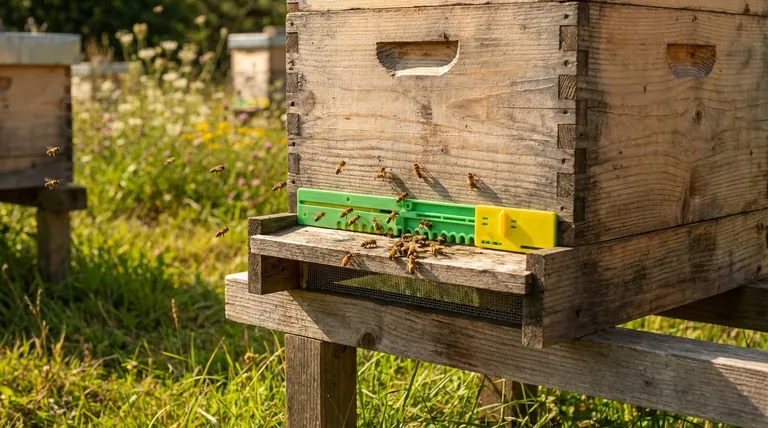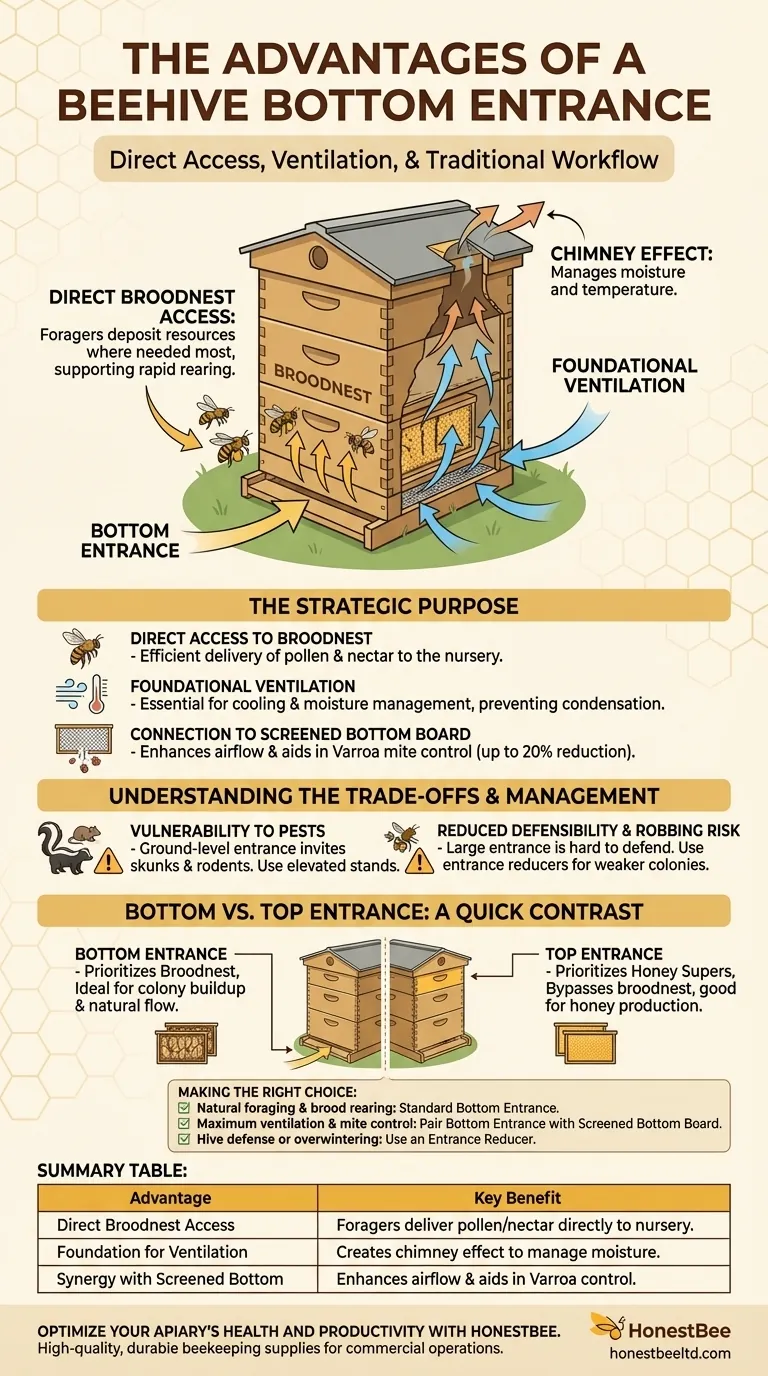A primary advantage of a bottom entrance is that it provides foraging bees with the most direct and efficient access to the broodnest. This traditional design also serves as a foundational component of the hive's ventilation system, especially when paired with a screened bottom board or upper vents to promote crucial airflow.
The bottom entrance is the classic, default design that aligns with a colony's natural workflow. However, its benefits in foraging efficiency must be carefully weighed against its inherent vulnerabilities to pests and defensibility challenges.

The Strategic Purpose of a Bottom Entrance
Understanding why the bottom entrance is so common requires looking at how it supports the colony's core functions: raising brood and managing the internal hive environment.
Direct Access to the Broodnest
A colony's "nursery" or broodnest is typically located in the lowest boxes of the hive.
A bottom entrance allows returning foragers carrying pollen and nectar to deposit their resources exactly where they are needed most with minimal travel time. This efficiency supports rapid brood rearing.
Foundational Ventilation
A bottom entrance is the primary intake for fresh air. This is critical for cooling the hive in the summer and, more importantly, for managing moisture during the winter.
When combined with a small upper entrance or ventilated inner cover, a bottom entrance creates a natural "chimney effect," allowing warm, moist air to rise and exit the hive, preventing harmful condensation.
Connection to the Bottom Board
The bottom entrance is part of the bottom board, which can be either solid or screened. A screened bottom board significantly enhances the benefits of a bottom entrance.
This design improves ventilation, helps control moisture, and allows Varroa mites and hive debris to fall out of the colony. This can reduce the Varroa population by up to 20%, though it is not a standalone treatment.
Understanding the Trade-offs
While traditional, the bottom entrance is not without significant drawbacks that require active management from the beekeeper.
Vulnerability to Pests and Predators
An entrance at ground level is an open invitation to pests. Skunks can easily access and harass the bees at night, and rodents may try to enter the hive for warmth in the winter.
Beekeepers often need to use entrance reducers or place hives on elevated stands to mitigate these specific threats.
Reduced Defensibility and Robbing Risk
A full-width bottom entrance can be a large, difficult-to-defend perimeter for the guard bees.
Weaker colonies are particularly susceptible to "robbing," where bees from stronger nearby hives invade to steal honey. A large entrance makes this much easier for intruders and harder for the home colony to repel.
How a Bottom Entrance Compares to a Top Entrance
To fully appreciate the choice, it's useful to contrast it with the main alternative. A top entrance fundamentally changes the hive's traffic flow and defensive posture.
Traffic Flow and Hive Goals
A top entrance provides foragers with direct access to the honey supers, bypassing the busy broodnest entirely. This can be an advantage for maximizing honey production in a strong, established colony.
In contrast, the bottom entrance prioritizes the broodnest, which is ideal for young or growing colonies focused on population buildup.
Environmental Factors
A bottom entrance is more likely to be blocked by heavy snow, dead bees, or overgrown vegetation, requiring more frequent checks from the beekeeper.
A top entrance is generally immune to these ground-level obstructions and can provide an essential exit for bees during deep winter snow.
Making the Right Choice for Your Goal
The best entrance strategy depends entirely on your colony's strength, your local environment, and your primary goals as a beekeeper.
- If your primary focus is natural foraging and brood rearing: The standard bottom entrance is the most efficient and time-tested design.
- If your primary focus is maximum ventilation and mite control: Pair a bottom entrance with a screened bottom board for superior airflow and debris removal.
- If your primary focus is hive defense or overwintering: Use an entrance reducer to shrink the bottom entrance, making it easier for your bees to guard and manage.
Ultimately, managing your hive's entrance is a critical lever for influencing its health, safety, and productivity.
Summary Table:
| Advantage | Key Benefit |
|---|---|
| Direct Broodnest Access | Foragers deliver pollen/nectar directly to the nursery, supporting rapid colony growth. |
| Foundation for Ventilation | Creates a natural chimney effect with an upper exit to manage moisture and temperature. |
| Synergy with Screened Bottom | Enhances airflow and aids in Varroa mite control by allowing debris to fall through. |
Optimize Your Apiary's Health and Productivity with HONESTBEE
Choosing the right hive configuration, including entrance type, is fundamental to successful beekeeping. At HONESTBEE, we supply commercial apiaries and beekeeping equipment distributors with the high-quality, durable supplies needed to build and manage thriving operations.
Let us help you equip your hives for success. Contact our wholesale team today to discuss your needs and explore our full catalog of beekeeping solutions.
Visual Guide

Related Products
- Multi-Functional Sliding Hive Entrance for Beekeeping
- Multi-Functional Rotary Hive Entrance Disc for Beekeeping
- Boardman Entrance Bee Feeder Durable Galvanized Steel and Wood Construction for Beekeeping
- Professional Hive Front Entrance Bee Feeder
- Beehive Entrance Discs Plastic Bee Entrance Disc for Bee Hives
People Also Ask
- What size is the entrance hole in a native bee hive? The 13mm Standard for a Thriving Colony
- How can a Langstroth hive entrance be adjusted? Mimic Natural Bee Preferences for a Healthier Hive
- What is the purpose of placing an object in front of the hive entrance after a move? A Guide to Forced Reorientation
- How does the sliding design of the entrance reducer benefit beekeepers? Achieve Ultimate Hive Control
- What additional functions do hive entrances serve? A Key to Colony Health, Security, and Productivity



















